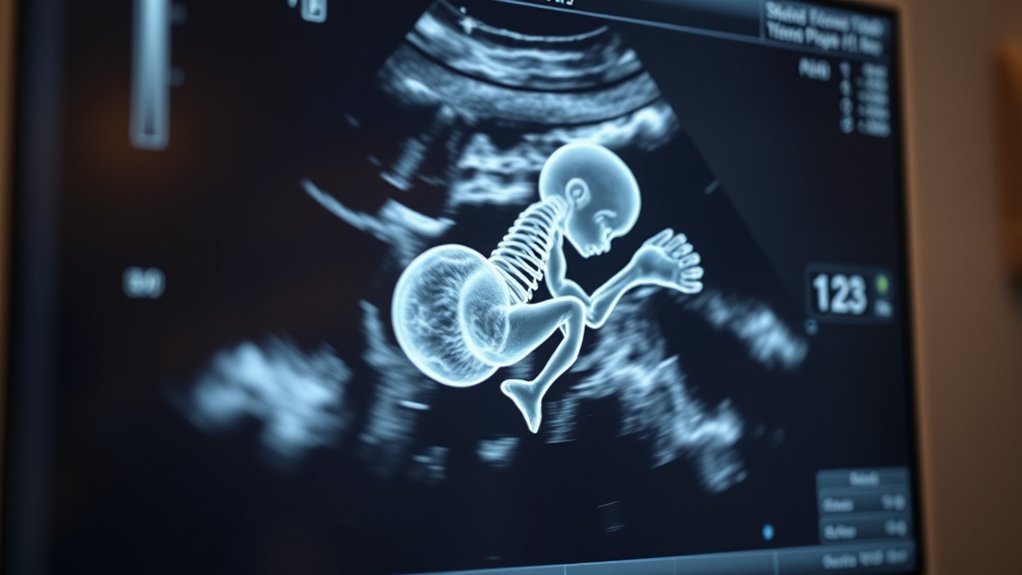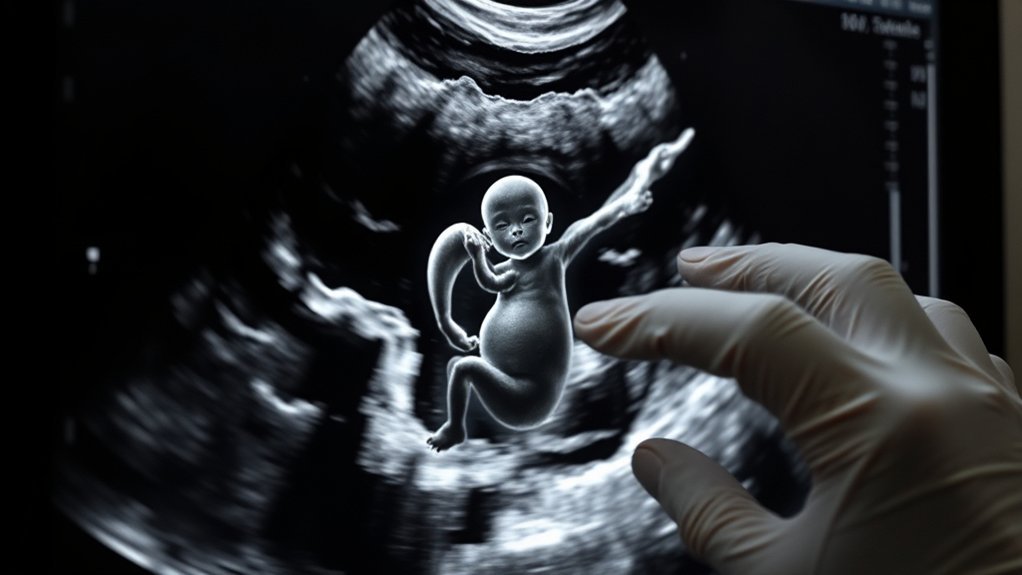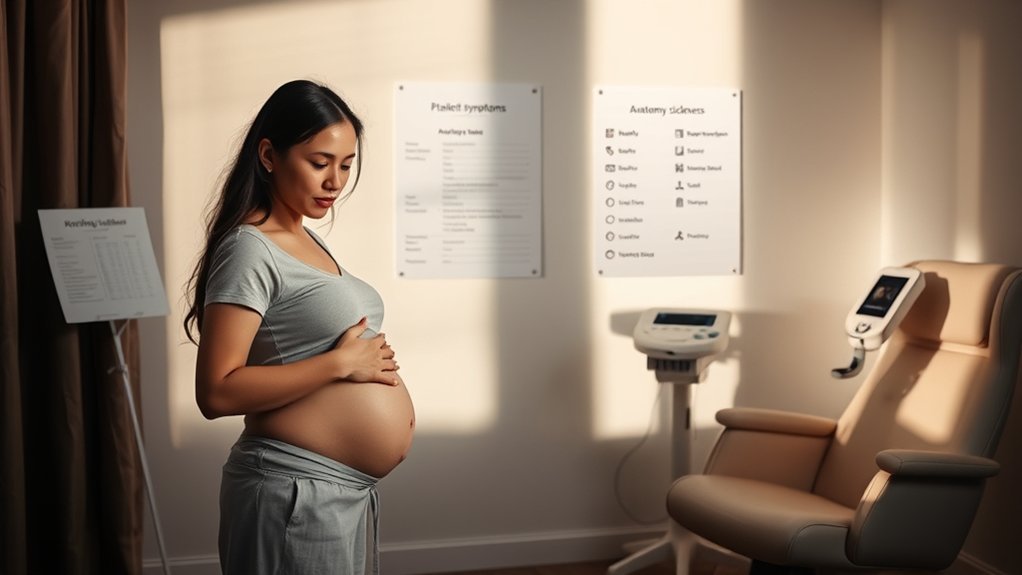The anatomy scan is an essential part of your pregnancy, typically occurring between 18 and 22 weeks. It helps assess your baby’s growth and development. However, it’s important to stay alert for symptoms that might indicate potential issues. Persistent abdominal pain or sudden swelling in your hands and feet could be signs of complications. Understanding these symptoms can prepare you for what lies ahead and guarantee you’re ready for the scan’s outcomes.
Importance of the Anatomy Scan

The anatomy scan, often referred to as the mid-pregnancy ultrasound, plays an essential role in prenatal care. This procedure typically occurs between 18 and 22 weeks of gestation and allows you to visualize your baby’s growth and development.
During this scan, healthcare providers assess the baby’s organs, limbs, and overall anatomical structure, ensuring everything is developing as expected. You’ll also receive critical information regarding the placenta’s position and amniotic fluid levels.
By identifying potential abnormalities early, the anatomy scan helps facilitate timely interventions if necessary. Additionally, it can provide you with reassurance about your baby’s health, helping to prepare you for the upcoming birth.
Common Symptoms Indicating Potential Issues

While many pregnancies progress smoothly, certain symptoms can indicate potential issues that warrant further investigation. You should be alert to symptoms like persistent abdominal pain, which may suggest complications such as ectopic pregnancy or placental issues.
Unexplained bleeding or spotting can also be concerning, as it may signal miscarriage or other complications. If you experience severe headaches, vision changes, or sudden swelling of hands and feet, these might indicate preeclampsia.
Additionally, a significant decrease in fetal movement, especially in the third trimester, requires immediate attention. Remember, early detection of these symptoms can lead to timely interventions, so don’t hesitate to consult your healthcare provider if you have any concerns about your pregnancy.
Your health and that of your baby are paramount.
Signs to Monitor Before the Scan

Monitoring specific signs before your anatomy scan can enhance your awareness of your pregnancy’s progress. Pay attention to any unusual abdominal pain, which could indicate underlying issues.
Spotting or heavy bleeding should also be closely monitored, as these may signal complications. Notice if you experience severe headaches or visual disturbances, as they can be associated with conditions like preeclampsia.
Changes in fetal movement, such as a significant decrease, warrant immediate attention. Additionally, monitor your swelling, especially in the hands and face, as this could be a sign of problems.
Keeping track of these symptoms allows you to communicate effectively with your healthcare provider, ensuring a thorough evaluation during your anatomy scan.
Emotional Preparedness for the Anatomy Scan
Preparing emotionally for your anatomy scan is essential, as this appointment can bring both excitement and anxiety. It’s normal to feel a mix of emotions, so consider these strategies to help you cope effectively:
| Emotion | Strategy | Expected Outcome |
|---|---|---|
| Anxiety | Practice deep breathing | Reduced stress levels |
| Excitement | Visualize positive outcomes | Increased optimism |
| Uncertainty | Discuss concerns with a partner | Enhanced support |
Acknowledging your feelings can help you approach the scan with a balanced mindset. Remember, it’s okay to seek support from friends, family, or professionals to navigate these emotions. Preparing yourself emotionally can lead to a more positive experience during your anatomy scan.
Post-Scan Considerations and Next Steps
After your anatomy scan, it’s important to understand the implications of the results and what steps to take next. Follow these post-scan considerations:
Understanding your anatomy scan results is crucial for planning your next steps and addressing any concerns.
- Review Results with Your Provider: Schedule a follow-up appointment to discuss findings and any concerns.
- Ask Questions: Prepare questions about any abnormalities or further tests needed.
- Emotional Support: Consider seeking support from friends, family, or a counselor if the results are concerning.
- Plan for Next Steps: Depending on the results, your healthcare provider may recommend additional imaging or monitoring.
Frequently Asked Questions
How Is the Anatomy Scan Performed?
During the anatomy scan, you lie on an examination table while a technician applies gel to your abdomen. They use a transducer to capture images of your baby’s organs, measuring growth and identifying any potential issues.
What Happens if Abnormalities Are Detected?
If abnormalities are detected, your healthcare provider discusses potential implications and next steps. They may recommend further testing or specialist consultations, guiding you through options while ensuring you understand the situation and its significance.
Can I Bring Someone to the Scan?
Yes, you can bring someone to the scan. Many facilities encourage support persons for emotional comfort. Just check with the clinic beforehand, as some may have specific policies regarding the number of attendees allowed.
Are There Any Risks Involved With the Scan?
While anatomy scans are generally safe, minimal risks exist, such as misinterpretation of results or exposure to unnecessary anxiety. It’s essential to discuss any concerns with your healthcare provider before the procedure to guarantee clarity.
How Long Does the Anatomy Scan Take?
The anatomy scan typically takes about 30 to 60 minutes. During this time, you’ll lie comfortably while the technician captures detailed images of your baby’s growth and development, ensuring everything’s progressing as expected.
Conclusion
To summarize, the anatomy scan is a crucial assessment of your baby’s health, with studies showing that it can detect up to 80% of major congenital anomalies. Staying alert to symptoms like abdominal pain or changes in fetal movement can lead to timely interventions. Remember, emotional preparedness is equally important; this scan can bring both excitement and anxiety. After the scan, discussing results with your healthcare provider guarantees you understand any necessary next steps for your pregnancy.
